Effect of Tip Clearance on Flow Field and Heat Transfer Characteristics in a Large Meridional Expansion Turbine
Abstract
1. Introduction
2. Numerical Methods
2.1. Turbine in Study and Boundary Conditions
2.2. Numerical Solver and Mesh
2.3. Experimental Validation of Numerical Models
2.4. Gap Configuration
3. Results and Discussion
3.1. Secondary Flow in S2
3.2. Aerodynamic Analysis of S2 with Different R1 Tip Clearance
3.3. Heat Transfer Analysis of S2 with Different R1 Tip Clearance
3.4. Comparison of Aerodynamics and Heat Transfer Performance of S2
4. Conclusions
- The passage vortices moved obviously toward the middle of the large meridional expansion stator at the span position. The separation and attachment point of the horseshoe vortex on the pressure side had an advance of 15%, when compared with non-expansion stators.
- The increase of clearance size increased the strength of the tip leakage vortex and made it move toward the middle of the blade passage. The tip leakage vortex increased the local negative incidence angle of the downstream stator.
- For the downstream large meridional expansion stator, the upstream rotor tip clearance mainly affected the static pressure coefficient of 60% in front of the suction pressure. The shrouded rotor could reduce the adverse-pressure region by 25%.
- The shrouded rotor increased the upper passage vortex of the downstream large meridional expansion stator.
- The upstream tip leakage vortex significantly increased the high heat transfer area of a large meridional expansion stator suction surface. The intensity of the heat transfer area was significantly reduced by the upstream rotor with shroud.
- The upstream tip leakage vortex mainly enhanced the heat transfer coefficient of the leading edge of the endwall, while the upstream shrouded rotor blade helped the heat transfer coefficient of the leading edge to be more uniform.
Author Contributions
Funding
Conflicts of Interest
Nomenclature
| Roman and Greek | |
| Nu | Nusselt number |
| p | pressure, kPa |
| q | heat flux, kW/ |
| T | temperature, K |
| adiabatic wall temperature, K | |
| gas temperature, K | |
| isothermal wall temperature, K | |
| u | velocity, m/s |
| inlet temperature, K | |
| Ω | rotation tensor |
| S | strain tensor |
| C | vane midspan true chord |
| k | thermal conductivity |
| average relative total pressure at the outlet, kPa | |
| average relative total pressure at the inlet, kPa | |
| pt | local relative total pressure, kPa |
| average static pressure at the outlet, kPa | |
| Cps | static pressure coefficient |
| ψ | dimensionless curve width |
| Ψ | curve |
| Subscripts, Superscripts, Abbreviations | |
| R1 | first rotor |
| S1 | first stator |
| S2 | second stator |
| Exp | experimental |
| PS, SS | pressure side, suction side |
| CFD | computational fluid dynamics |
| HTC | heat transfer coefficient |
| SST | shear stress transport |
| TLV | tip-leakage vortex |
| SV | shed vortex |
| AITEB | Aerothermal Investigation in Turbine Endwalls and Blades |
| RANS | Reynolds-Averaged Navier-Stokes |
References
- Bunker, R.S. Axial turbine blade tips: Function, design, and durability. J. Propuls. Power 2006, 22, 271–285. [Google Scholar] [CrossRef]
- Lin, A.; Sun, Y.; Zhang, H.; Lin, X.; Yang, L.; Zheng, Q. Fluctuating characteristics of air-mist mixture flow with conjugate wall-film motion in a compressor of gas turbine. Appl. Therm. Eng. 2018, 142, 779–792. [Google Scholar] [CrossRef]
- Lattime, S.B.; Steinetz, B.M. High-pressure-turbine clearance control systems: Current practices and future directions. J. Propuls. Power. 2004, 20, 302–311. [Google Scholar] [CrossRef]
- Ducoin, A.; Shadloo, M.S.; Roy, S. Direct Numerical Simulation of flow instabilities over Savonius style wind turbine blades. Renew. Energy 2017, 105, 374–385. [Google Scholar] [CrossRef]
- Denton, J.D. Loss mechanism in turbomachines. J. Turbomach. 1993, 115, 621–656. [Google Scholar] [CrossRef]
- Korschunov, B.A.; Döhler, S.W. Einfluß von Leckageströmungen an der Laufradspitze auf die aerodynamischen Characteristic des folgenden Leitgitters. BWKBd 1996, 48, 49–55. [Google Scholar]
- Anker, J.E.; Mayer, J.F. Simulation of the interaction of labyrinth seal leakage flow and main flow in an axial turbine. In Proceedings of the ASME Turbo Expo 2002: Power for Land, Sea, and Air, Amsterdam, The Netherlands, 3–6 June 2002. [Google Scholar]
- Peters, P.; Breisig, V.; Giboni, A.; Lerner, C.; Pfost, H. The influence of the clearance of shrouded rotor blades on the development of the flow field and losses in the subsequent stator. In Proceedings of the ASME Turbo Expo 2000: Power for Land, Sea, and Air, Munich, Germany, 8–11 May 2000. [Google Scholar]
- Duchaine, F.; Corpron, A.; Pons, L. Development and assessment of a coupled strategy for conjugate heat transfer with large eddy simulation: Application to a cooled turbine blade. Int. J. Heat Fluid Flow 2009, 30, 1129–1141. [Google Scholar] [CrossRef]
- Tafti, D.K.; He, L.; Nagendra, K. Large eddy simulation for predicting turbulent heat transfer in gas turbines. Philos. Trans. A Math. Phys. Eng. Sci. 2014, 372, 20130322. [Google Scholar] [CrossRef]
- Haselbach, F.; Schiffer, H.P. Aerothermal investigations on turbine endwalls and blades (AITEB). In Proceedings of the ASME Turbo Expo 2004: Power for Land, Sea, and Air, Vienna, Austria, 14–17 June 2004. [Google Scholar]
- Dannhauer, A. Analysis of cooling effectiveness and heat transfer variations on the endwall of a nozzle guide vane caused by turbine leakage flows. In Proceedings of the ASME Turbo Expo 2008: Power for Land, Sea, and Air, Berlin, Germany, 9–13 June 2008. [Google Scholar]
- Rehder, H.-J.; Dannhauer, A. Experimental Investigations of Turbine Leakage Flows on the Flow Field and Endwall Heat Transfer. J. Turbomach. 2007, 129, 608–618. [Google Scholar] [CrossRef]
- Qureshi, I.; Smith, A.D.; Povey, T. HP Vane Aerodynamics and Heat Transfer in the Presence of Aggressive Inlet Swirl. J. Turbomach. 2012, 135, 021040. [Google Scholar] [CrossRef]
- Fu, W.L.; Gao, J.; Liang, C.; Wang, F.K.; Zheng, Q.; Zhou, E.D. Experimental investigation on the annular sector cascade of a high endwall-angle turbine. In Proceedings of the ASME Turbo Expo 2016: Turbomachinery Technical Conference and Exposition, Seoul, Korea, 13–17 June 2016. [Google Scholar]
- Ameri, A.A.; Steinthorsson, E.; Rigby, D.L. Effect of squealer tip on rotor heat transfer and efficiency. J. Turbomach. 1998, 120, 753–759. [Google Scholar] [CrossRef]
- Balasubramanian, R.; Barrows, S.; Chen, J. Investigation of shear-stress transport turbulence model for turbomachinery applications. In Proceedings of the 46th AIAA Aerospace Sciences Meeting and Exhibit, Reno, NV, USA, 7–10 January 2006. [Google Scholar]
- Krishnababu, S.K.; Newton, P.J.; Dawes, W.N.; Lock, G.D.; Hodson, H.P.; Hannis, J.; Whitney, C. Aero-thermal investigations of tip leakage flow in axial flow turbines: Part I—Effect of tip geometry and tip clearance gap. In Proceedings of the ASME Turbo Expo 2007: Power for Land, Sea, and Air, Montreal, QC, Canada, 14–17 May 2007. [Google Scholar]
- Vidal, A.; Nagib, H.M.; Vinuesa, R. Vorticity fluxes and secondary flow: Relevance for turbulence modeling. Phys. Rev. Fluids 2018, 3, 072602(R). [Google Scholar] [CrossRef]
- Marin, O.; Vinuesa, R.; Obabko, A. Characterization of the secondary flow in hexagonal ducts. Phys. Fluids 2016, 28, 125101. [Google Scholar] [CrossRef]
- Zuckerman, N.; Lior, N. Impingement heat transfer: Correlations and numerical modeling. J. Heat Transf. 2005, 127, 544–552. [Google Scholar] [CrossRef]
- Bonelli, F.; Viggiano, A.; Magi, V. A numerical analysis of hydrogen underexpanded jets. In Proceedings of the Internal Combustion Engine Division Spring Technical Conference, Piemonte, Italy, 6–9 May 2012. [Google Scholar]
- Luo, J.; Razinsky, E.H. Prediction of heat transfer and flow transition on transonic turbine airfoils under high freestream turbulence. In Proceedings of the ASME Turbo Expo 2008: Power for Land, Sea, and Air, Berlin, Germany, 9–13 June 2008. [Google Scholar]
- Montomoli, F.; Adami, P.; Martelli, F. A finite-volume method for the conjugate heat transfer in film cooling devices. Proc. Inst. Mech. Eng. A J. Power Energy 2009, 223, 191–200. [Google Scholar] [CrossRef]
- El-Gabry, L.A.; Ameri, A.A. Comparison of steady and unsteady RANS heat transfer simulations of hub and endwall of a turbine blade passage. J. Turbomach. 2011, 133, 031010. [Google Scholar] [CrossRef]
- Jeong, J.; Hussain, F. On the identification of a vortex. J. Fluid Mech. 1995, 285, 69–94. [Google Scholar] [CrossRef]
- Sieverding, C.H. Understanding secondary flows in turbine bladings. In Proceedings of the State-of-the-Art & Impact on Blade Design, Gas Turbine Engineering Lecture Series, Orlando, FL, USA, 11–13 August 2004. [Google Scholar]
- Langston, L.S. Secondary flows in axial turbines—A review. Ann. N. Y. Acad. Sci. 2001, 934, 11–26. [Google Scholar] [CrossRef]
- Kost, F.; Nicklos, M. Film-cooled turbine endwall in a transonic flow field: Part I—Aerodynamic measurements. In Proceedings of the ASME Turbo Expo 2001: Power for Land, Sea, and Air, New Orleans, Louisiana, 4–7 June 2001. [Google Scholar]
- Laveau, B.; Abhari, R.S.; Crawfold, M.E.; Lutum, E. High resolution heat transfer measurements on the stator endwall of an axial turbine. In Proceedings of the ASME Turbo Expo 2014: Turbine Technical Conference and Exposition, Düsseldorf, Germany, 16–20 June 2014. [Google Scholar]
- Benner, M.W.; Sjolander, S.A.; Moustapha, S.H. Measurements of secondary flows in a turbine cascade at off-design incidence. In Proceedings of the ASME Turbo Expo 1997: International Gas Turbine and Aeroengine Congress and Exhibition, Orlando, FL, USA, 2–5 June 1997. [Google Scholar]
- Ricardo, V.; Carlos, R.Ö. Revisiting History Effects in Adverse-Pressure-Gradient Turbulent Boundary Layers. Flow Turbul. Combust. 2017, 99, 565–587. [Google Scholar]
- Méndez, M.; Shadloo, M.S.; Hadjadj, A.; Ducoin, A. Boundary Layer Transition Over a Concave Surface Caused by Centrifugal Instabilities. Comput. Fluids 2018, 171, 135–153. [Google Scholar] [CrossRef]
- Salvadori, S.; Montomoli, F.; Martelli, F. Analysis on the Effect of a Nonuniform Inlet Profile on Heat Transfer and Fluid Flow in Turbine Stages. ASME J. Turbomach. 2011, 134, 011012. [Google Scholar]
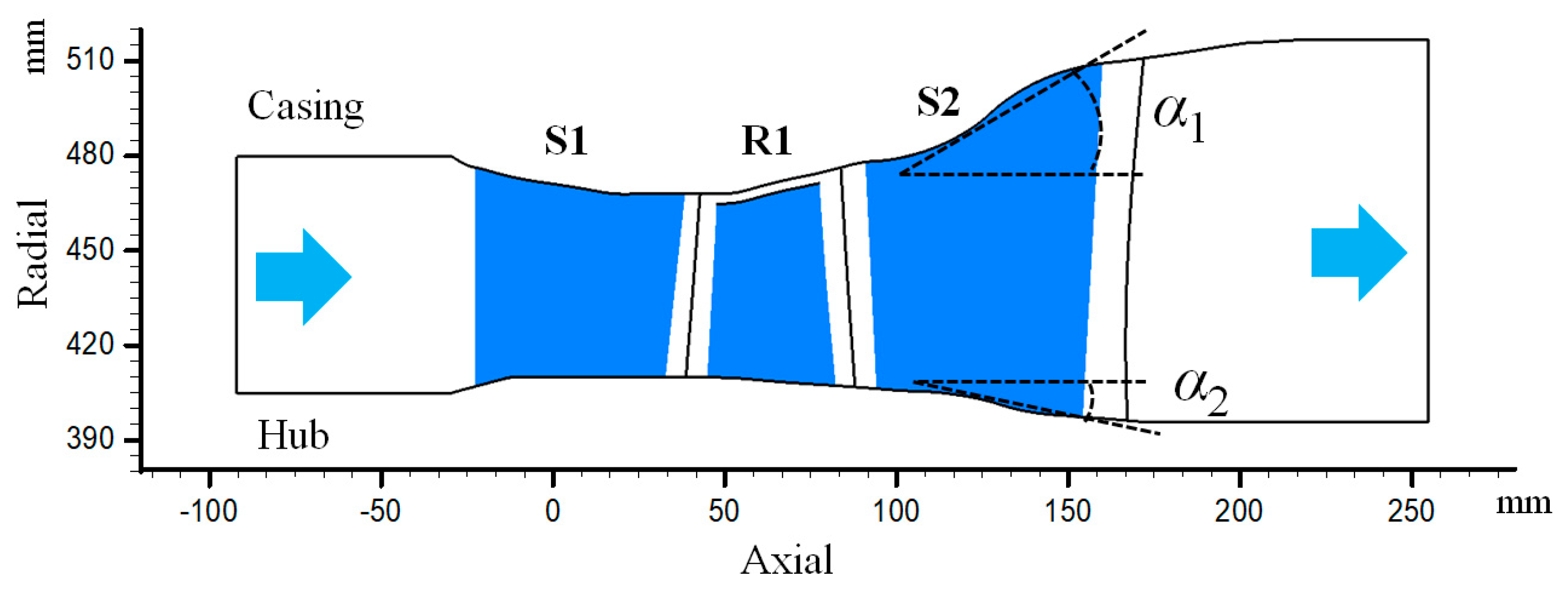
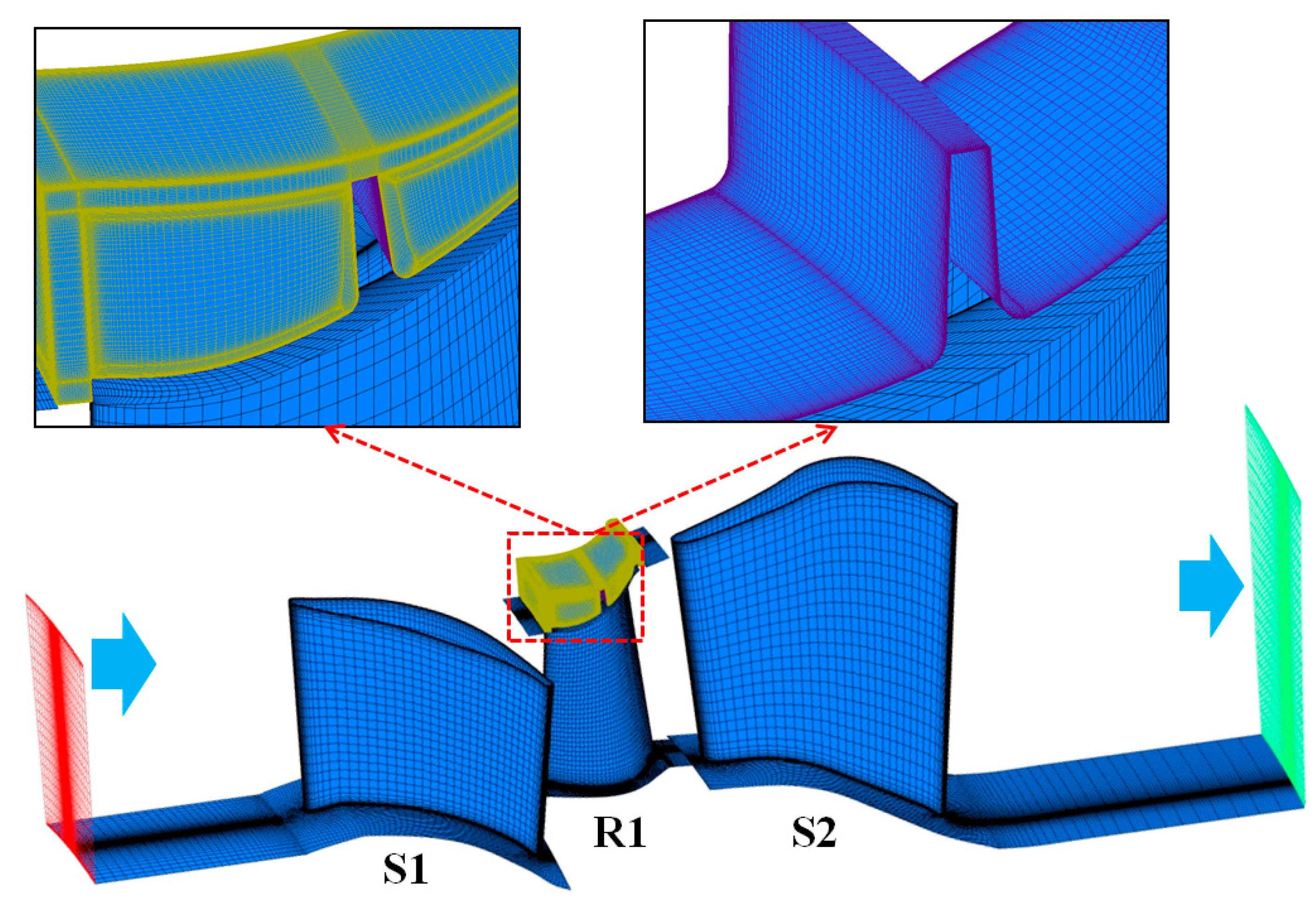
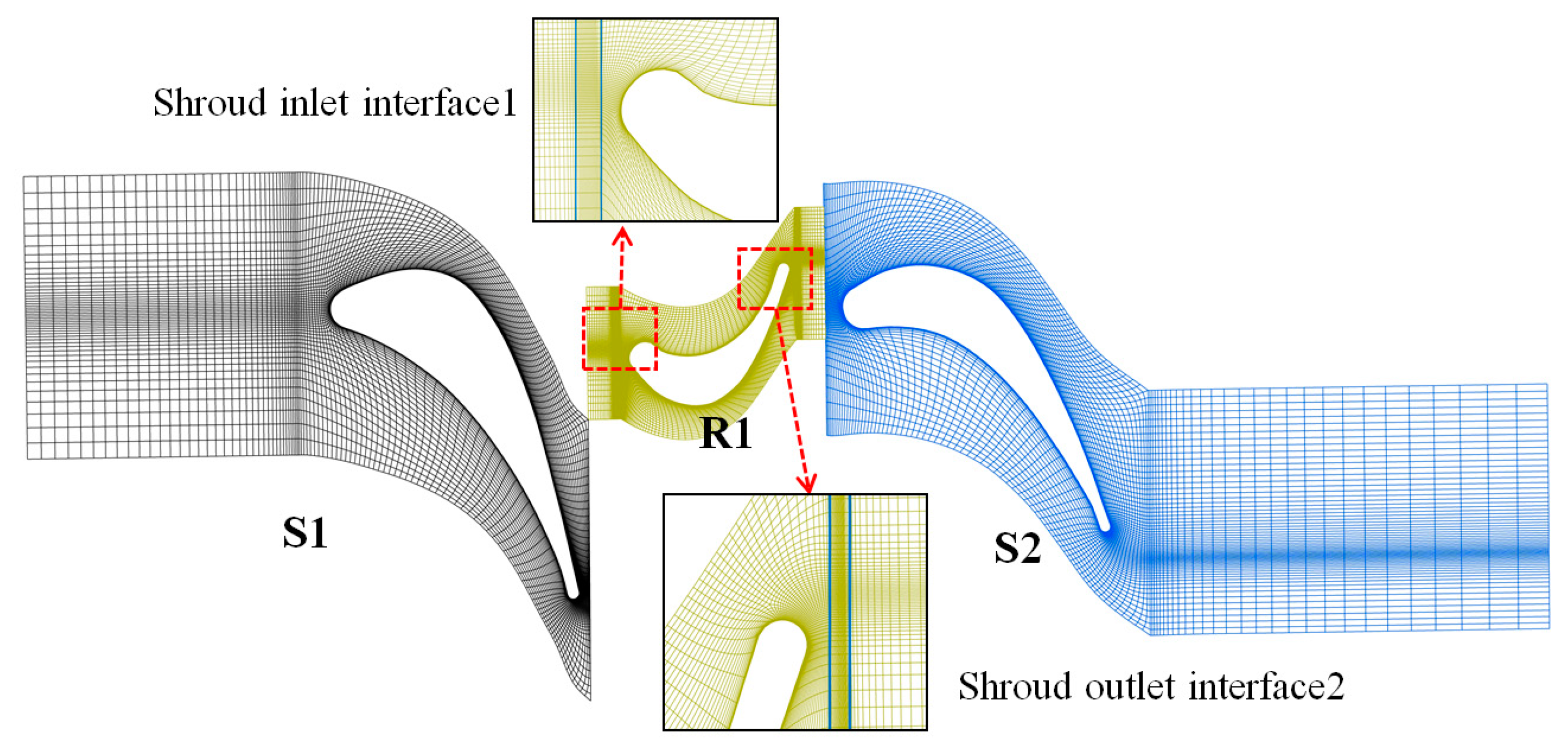
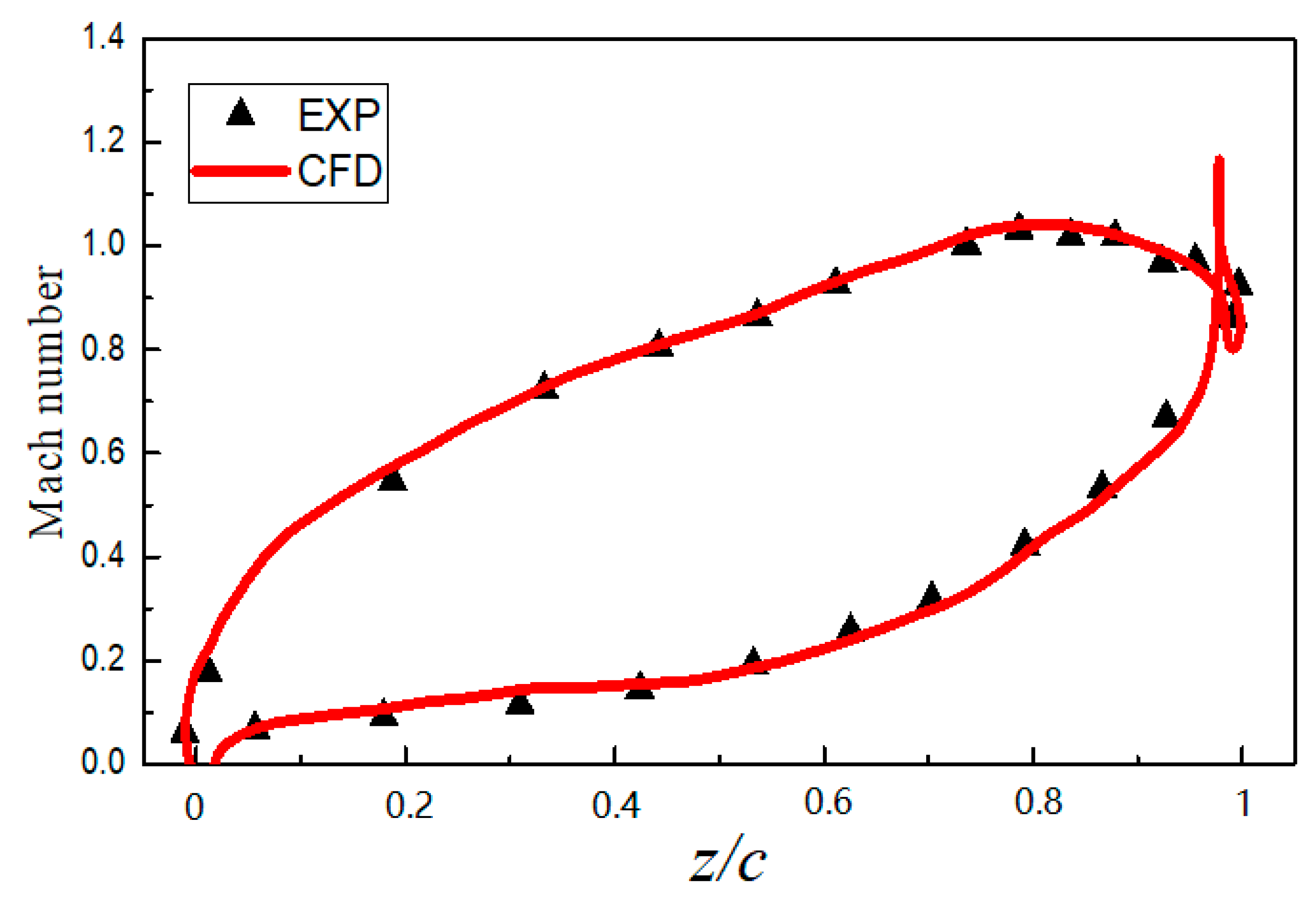
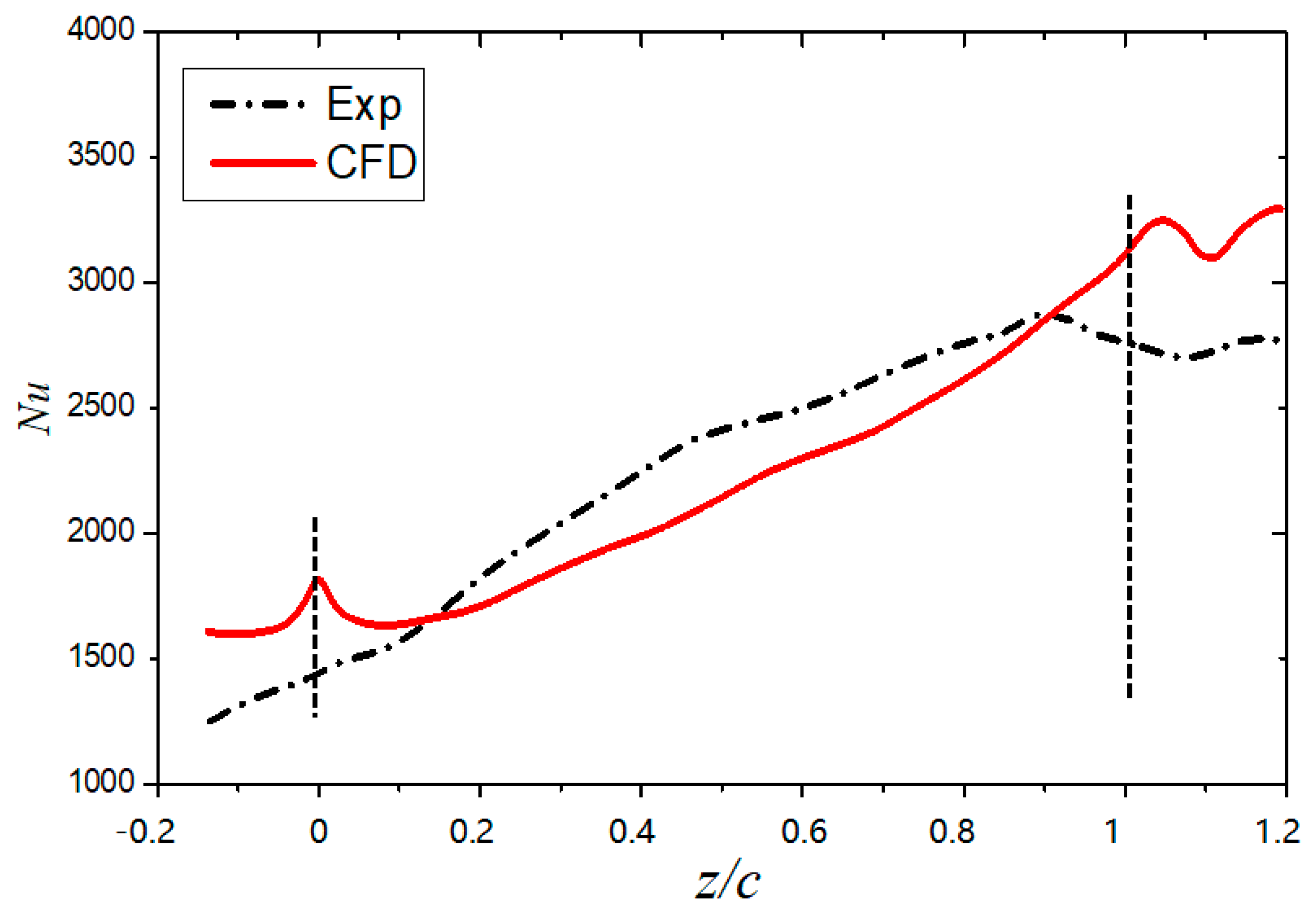
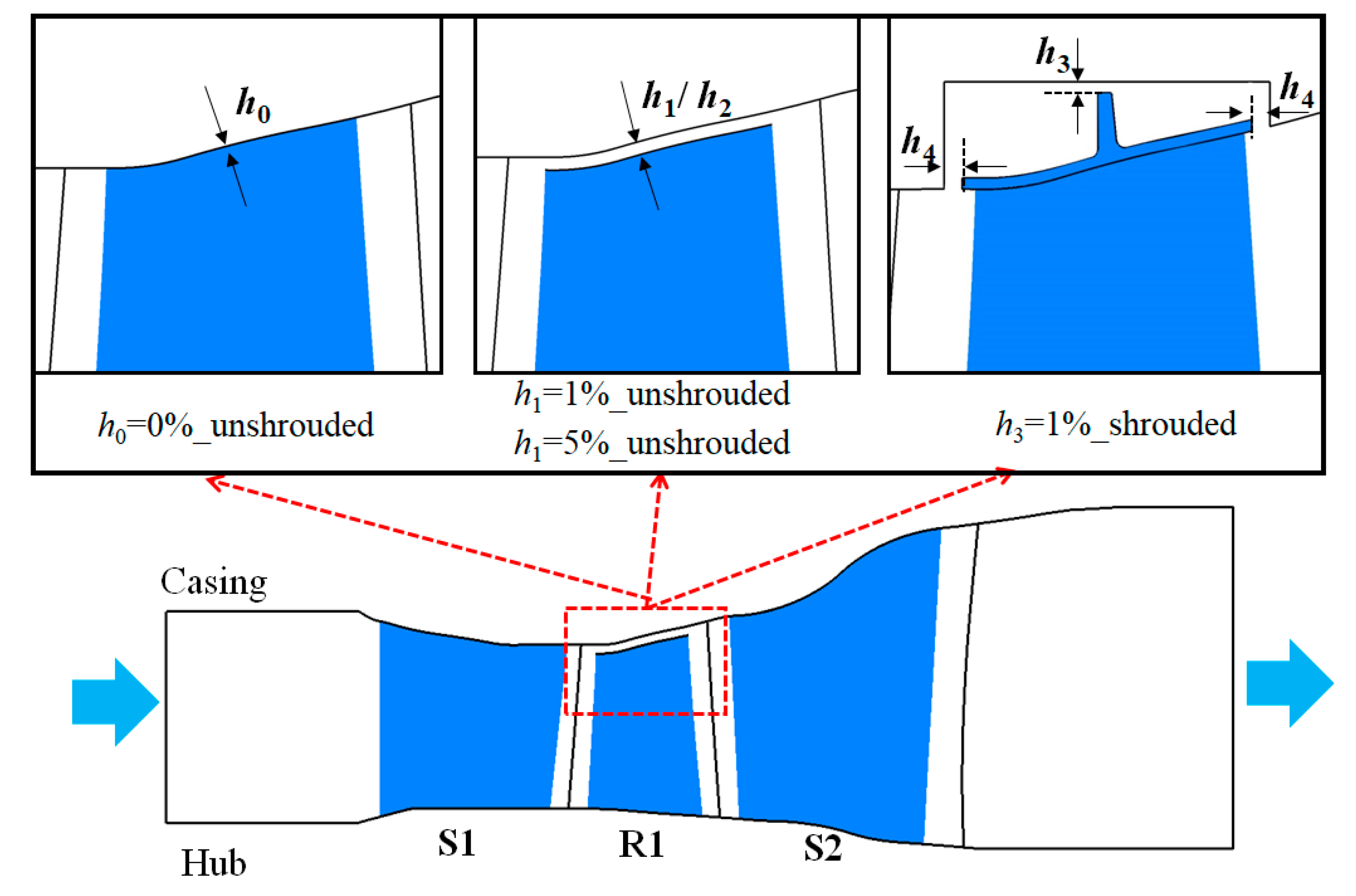
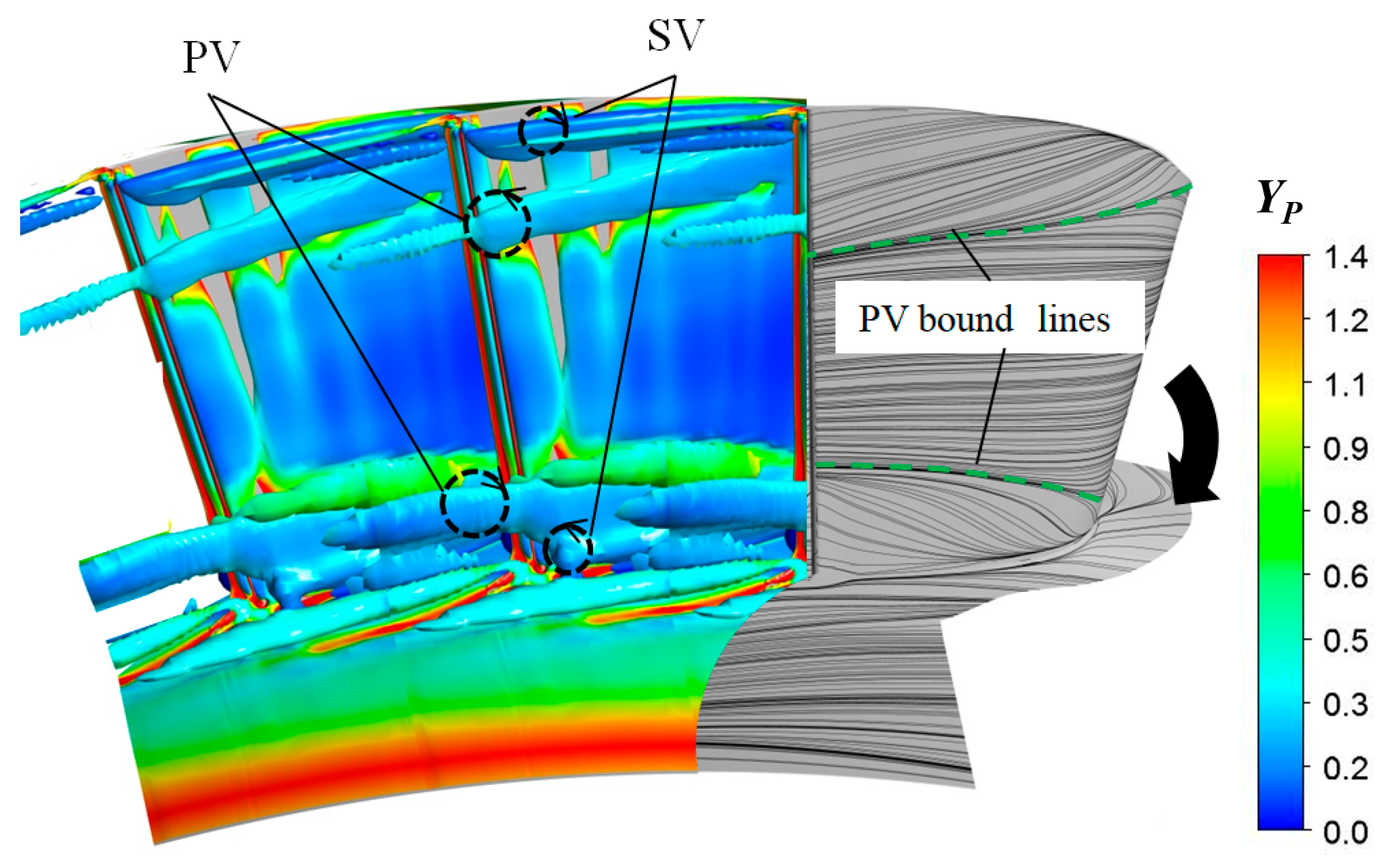
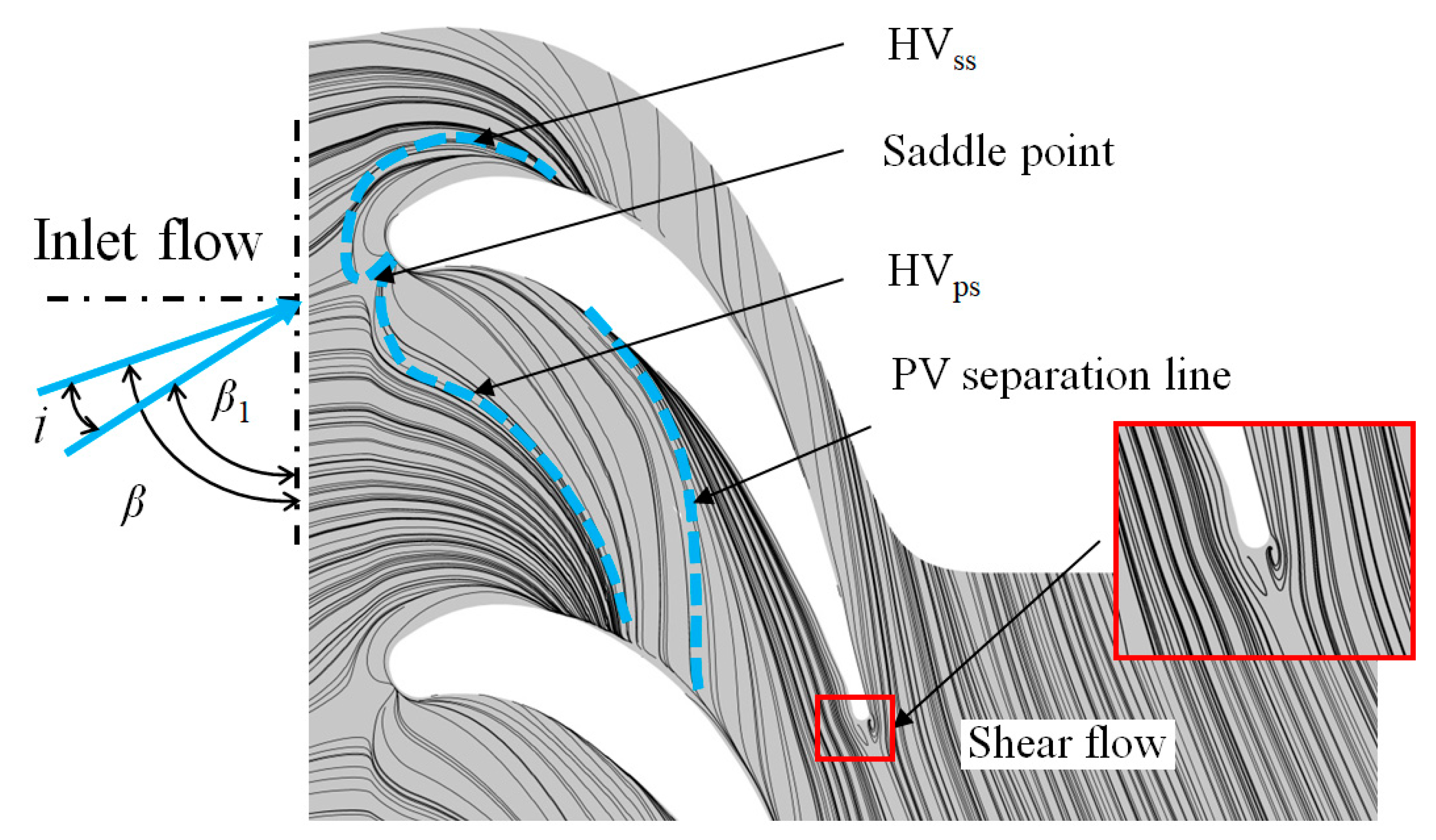
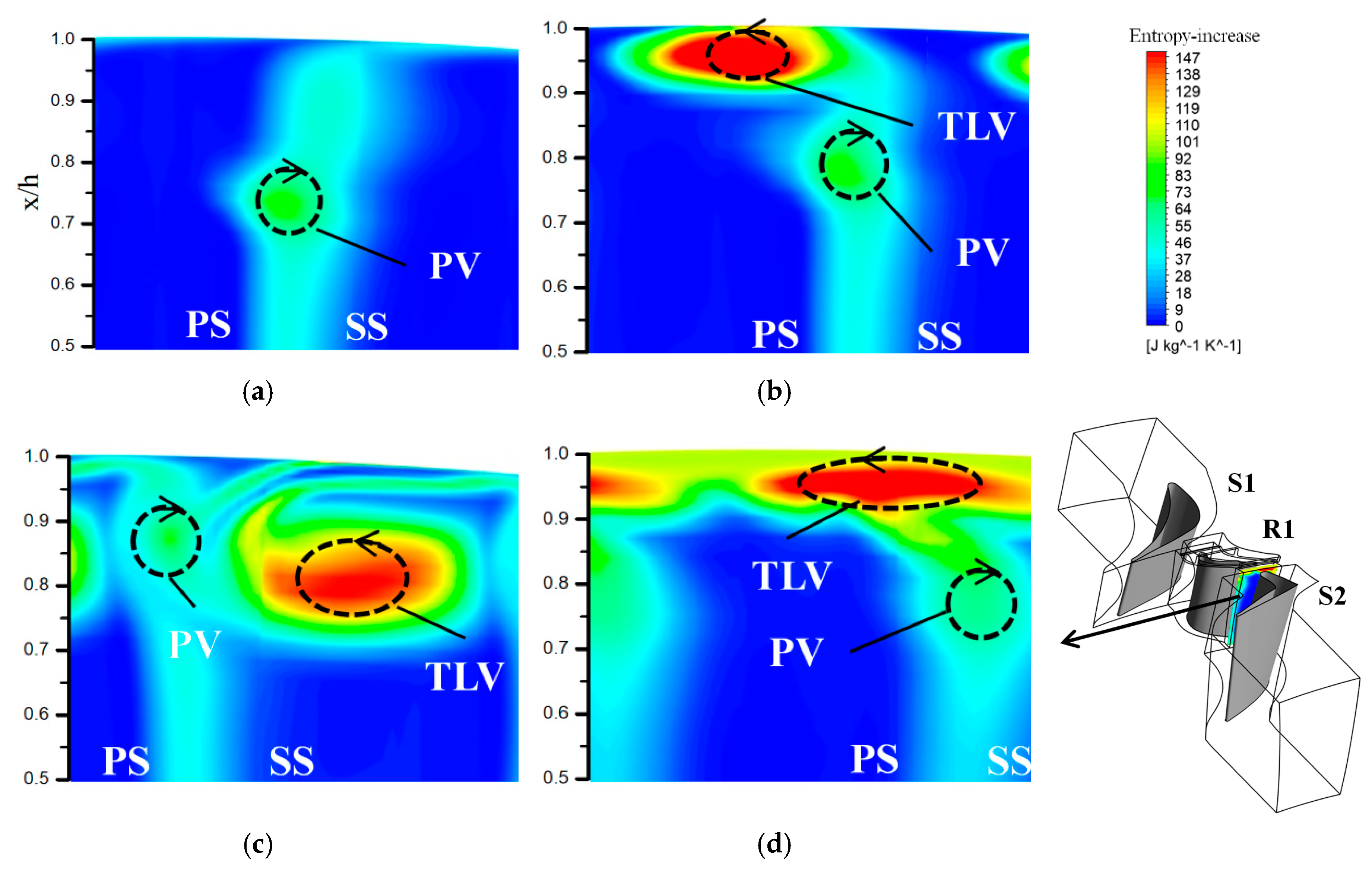
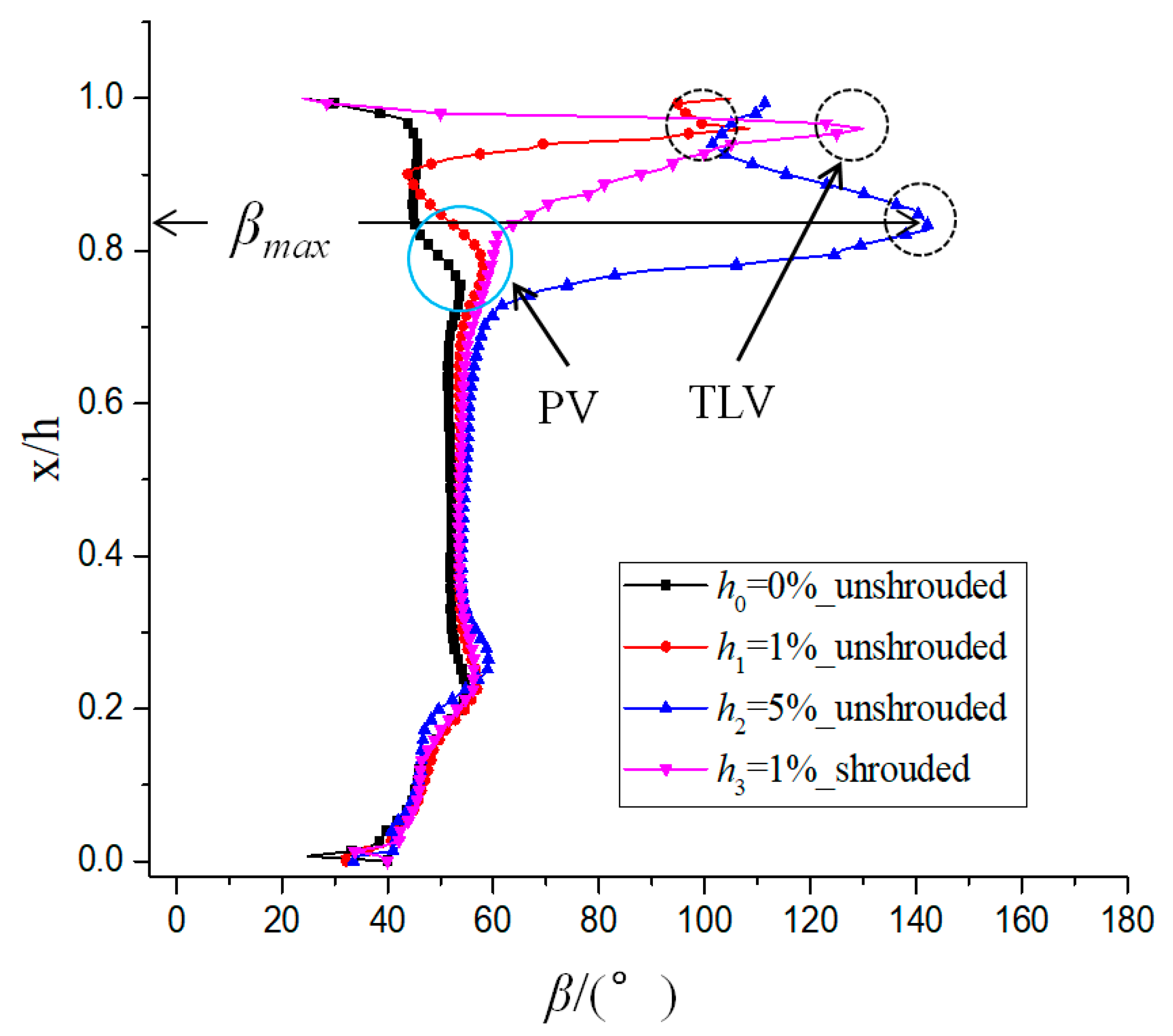
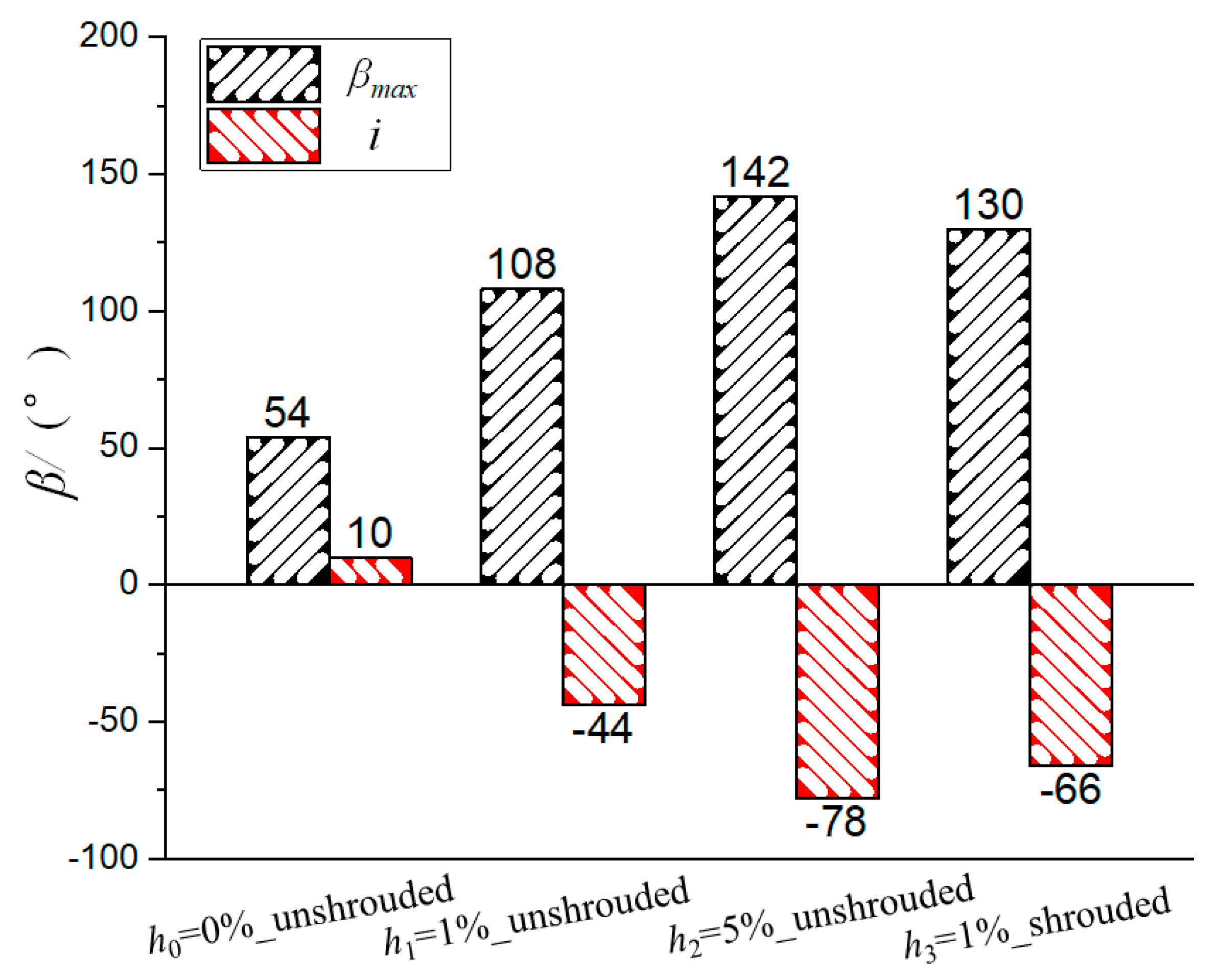
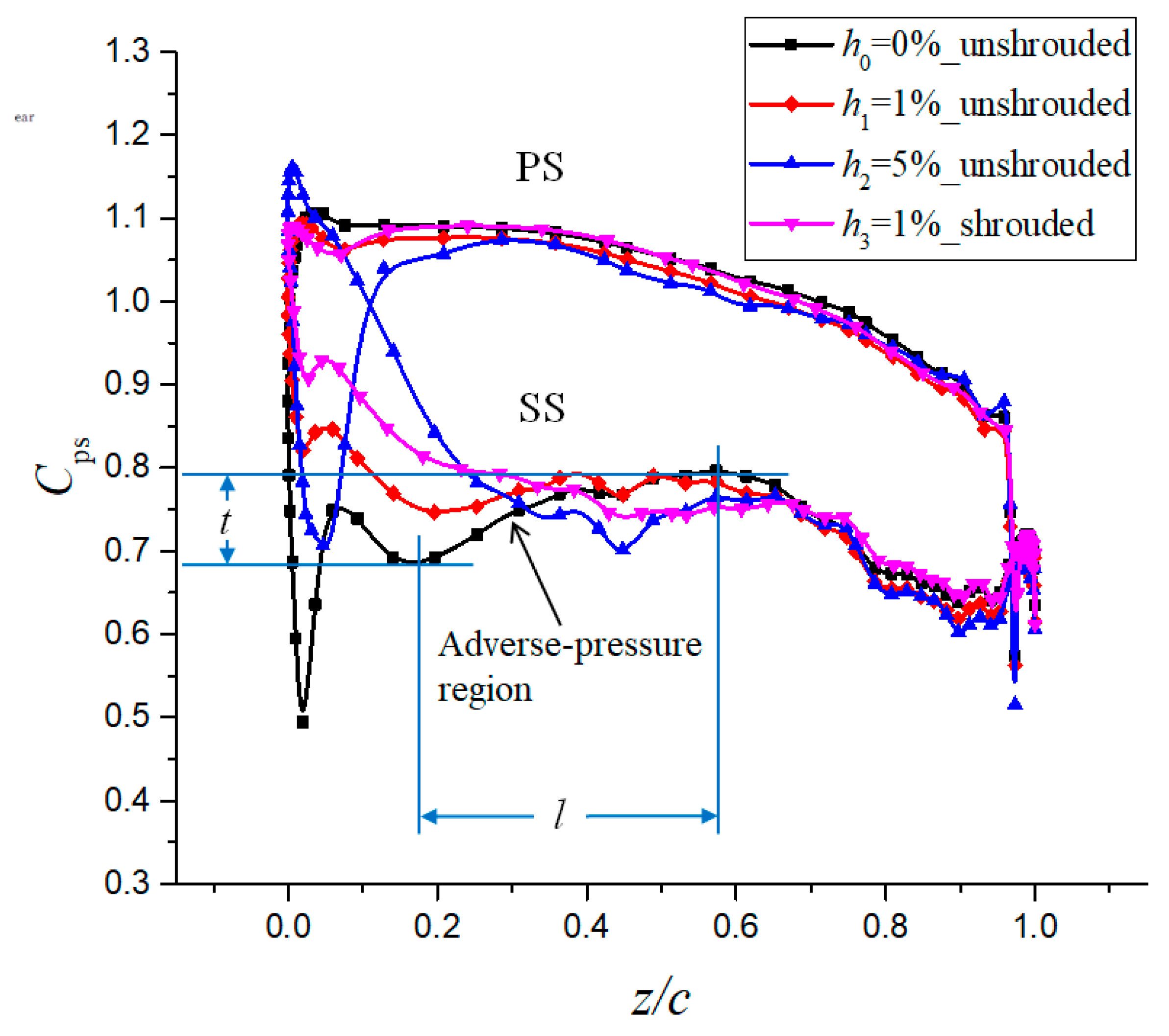
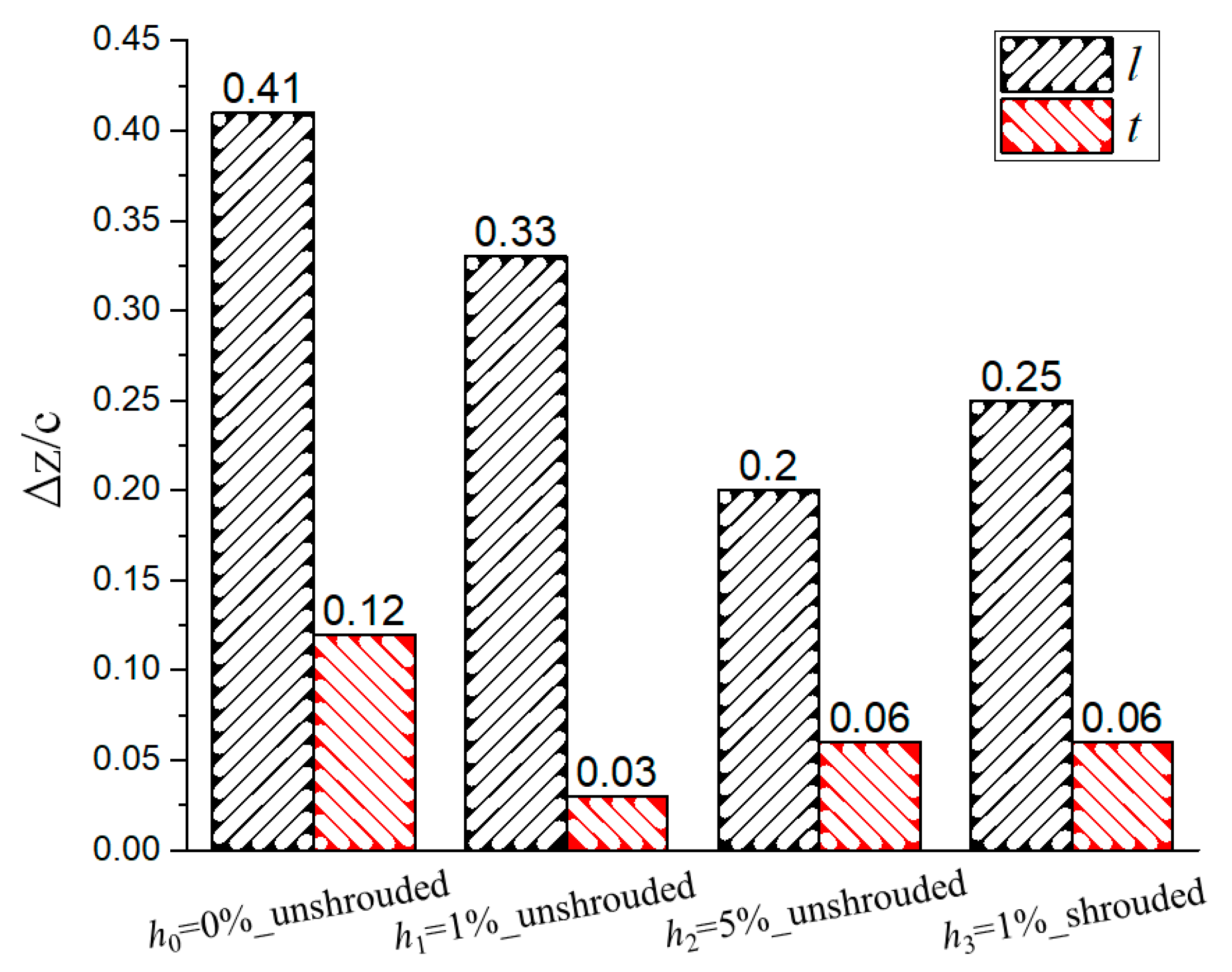
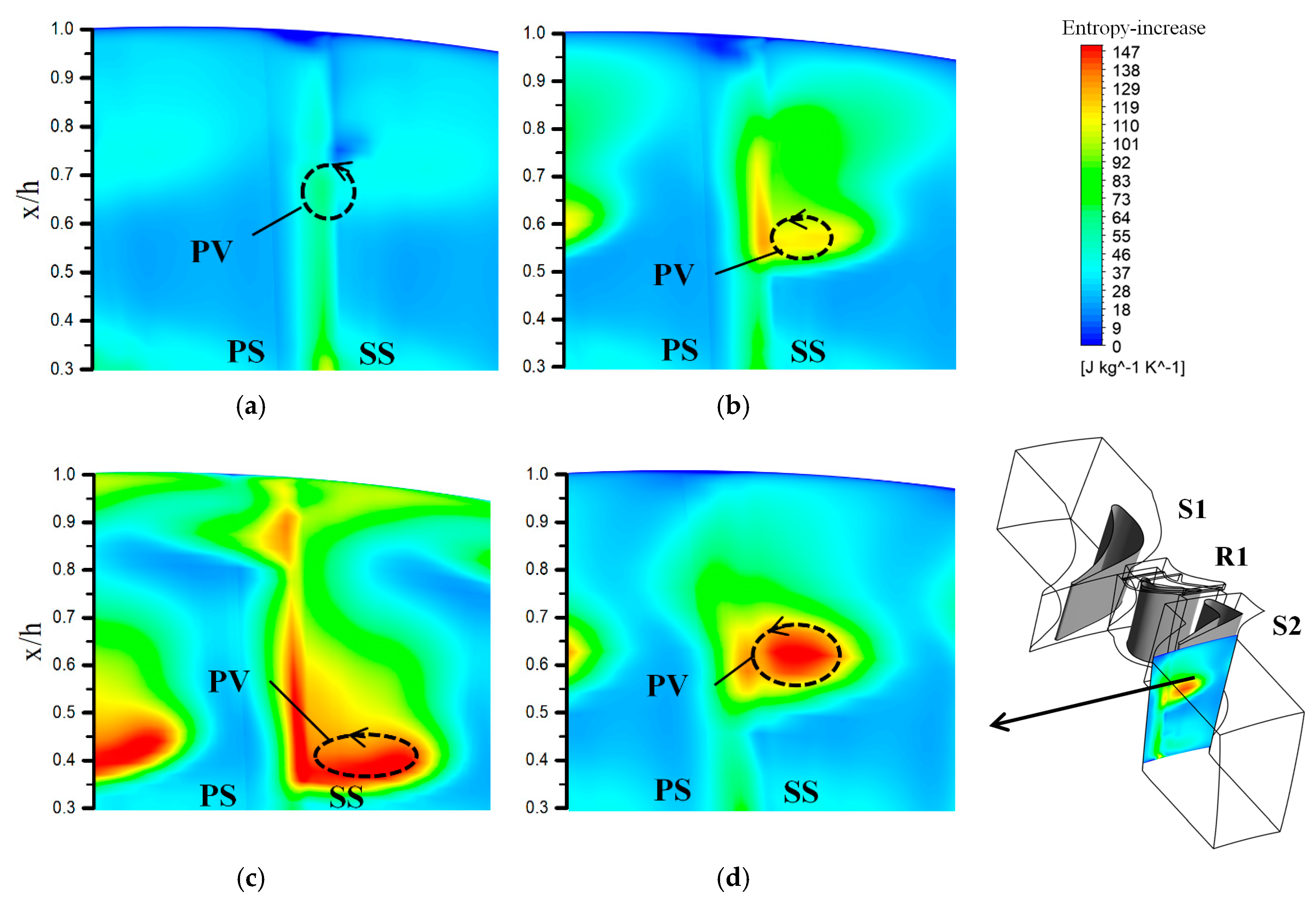
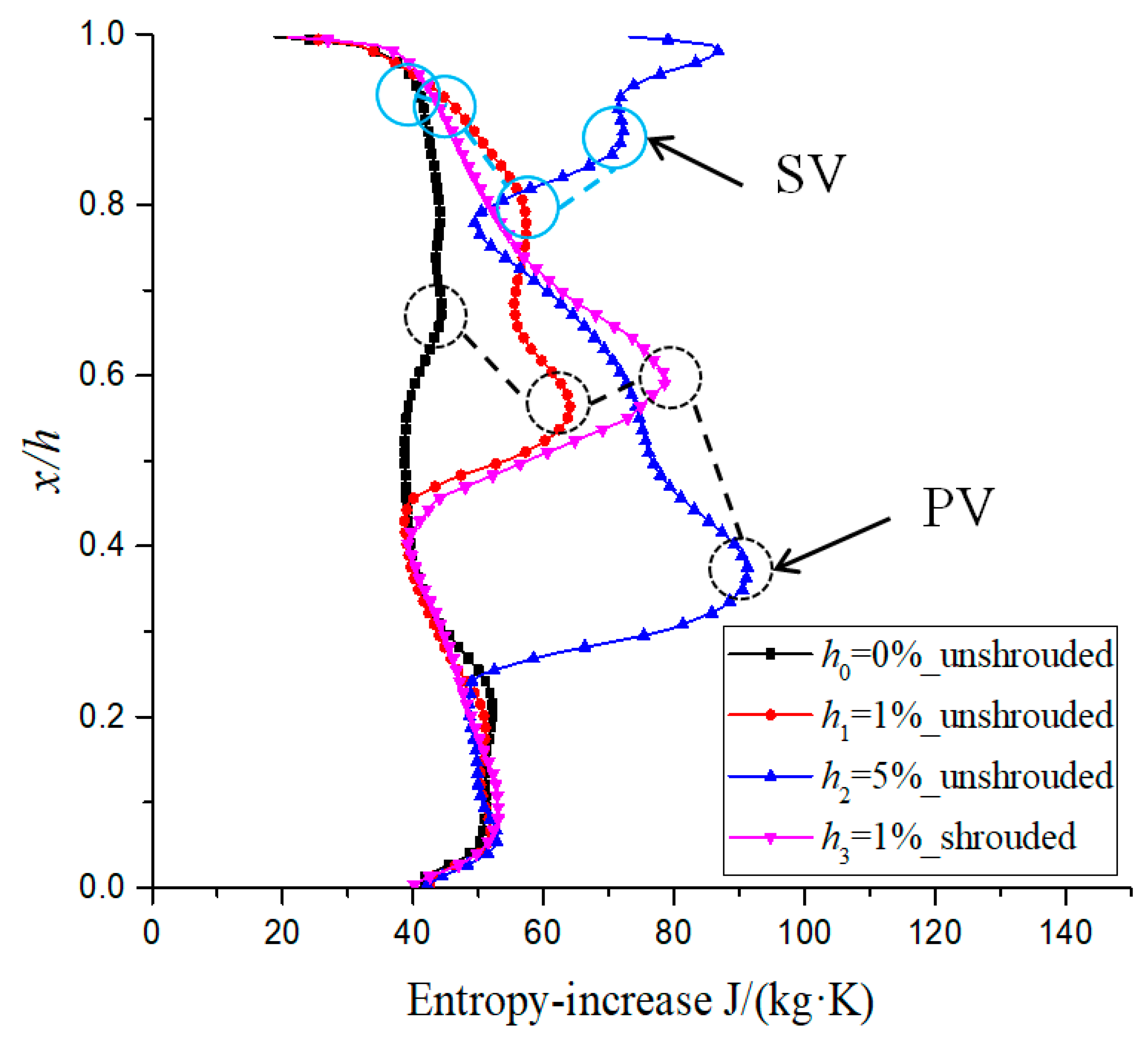
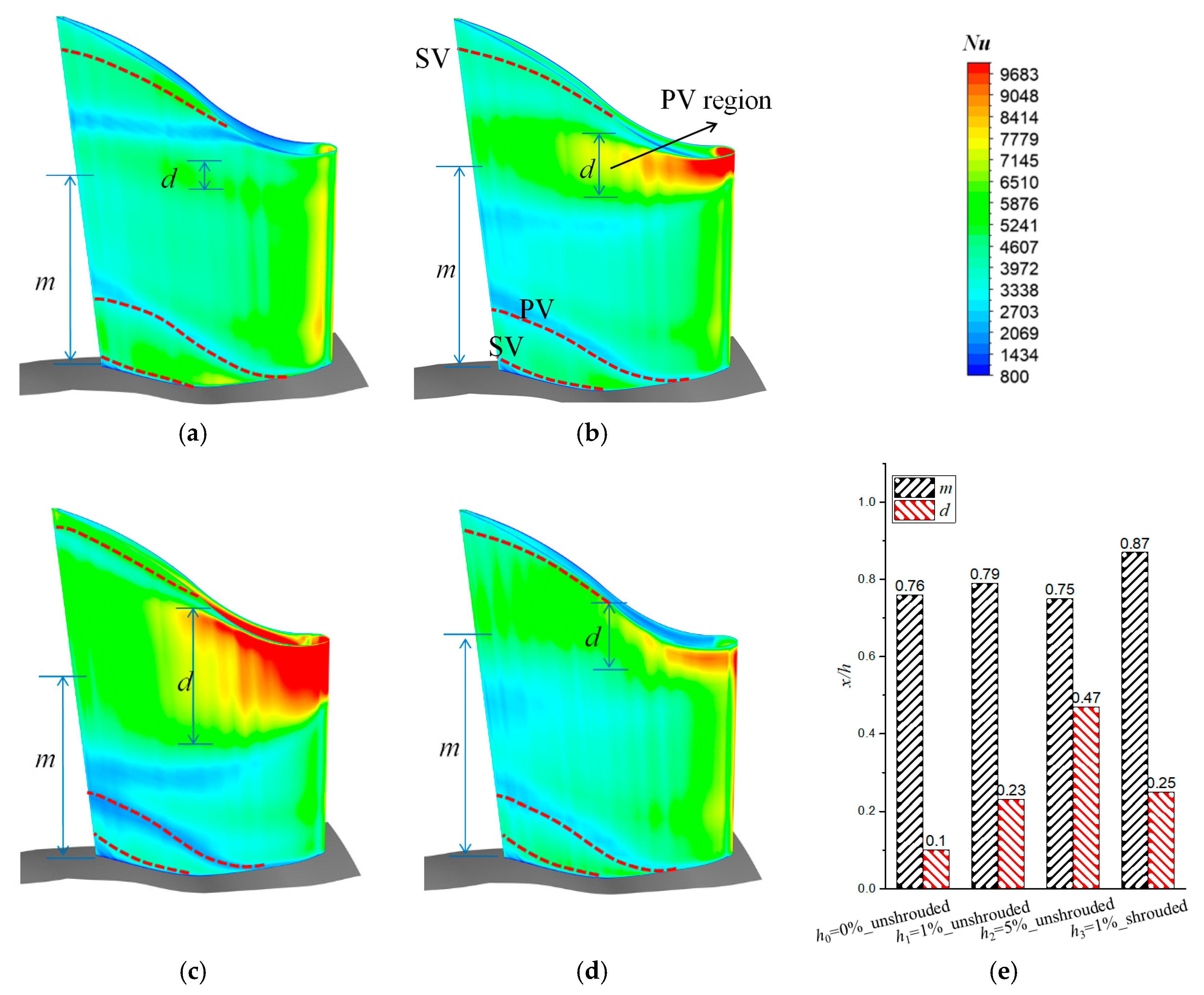
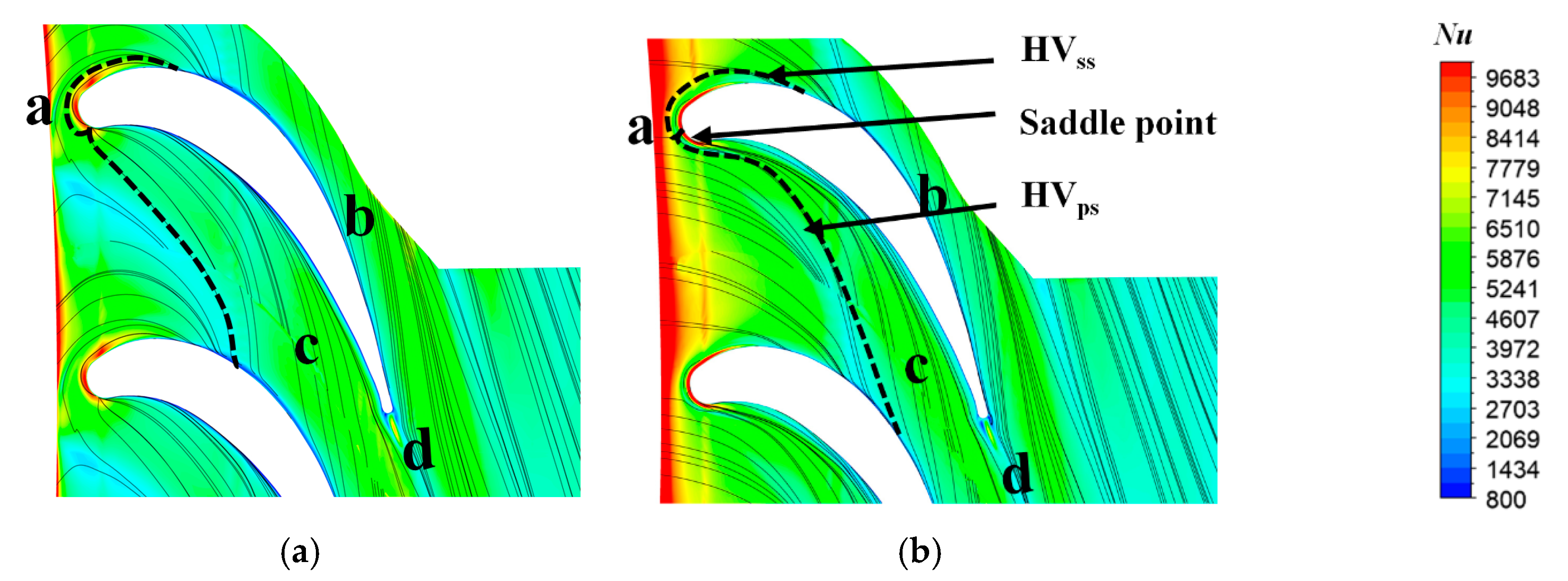
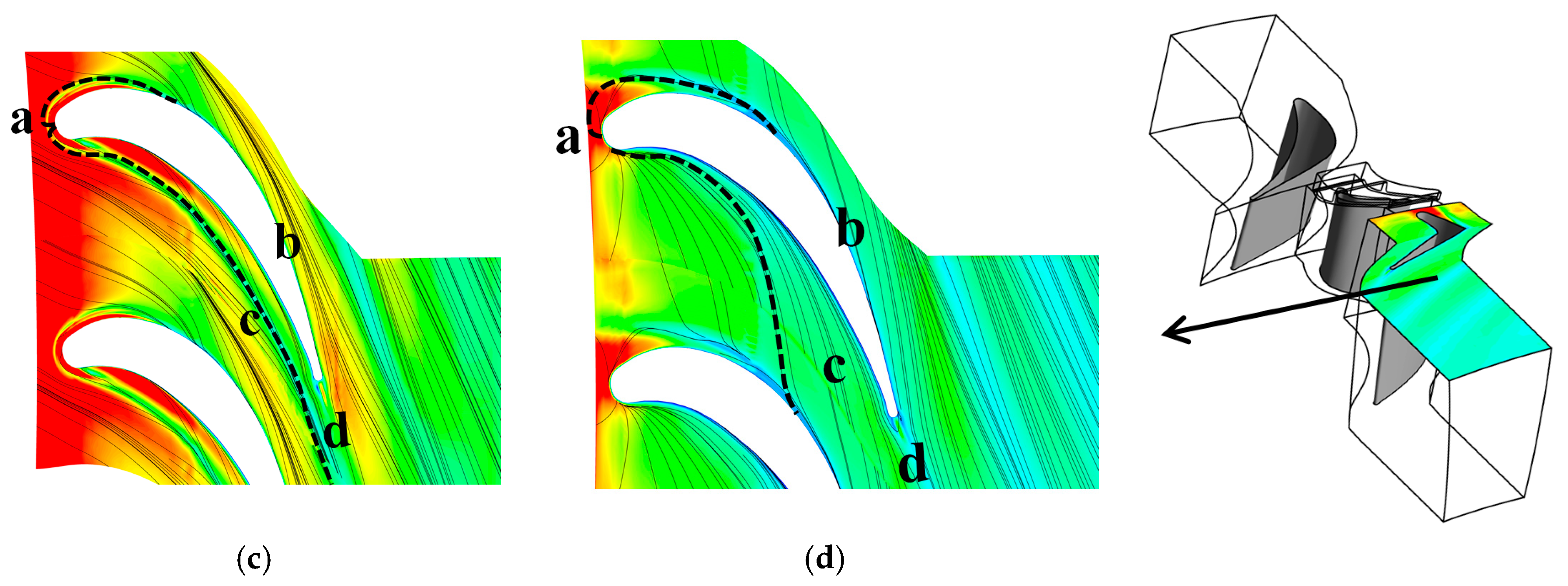
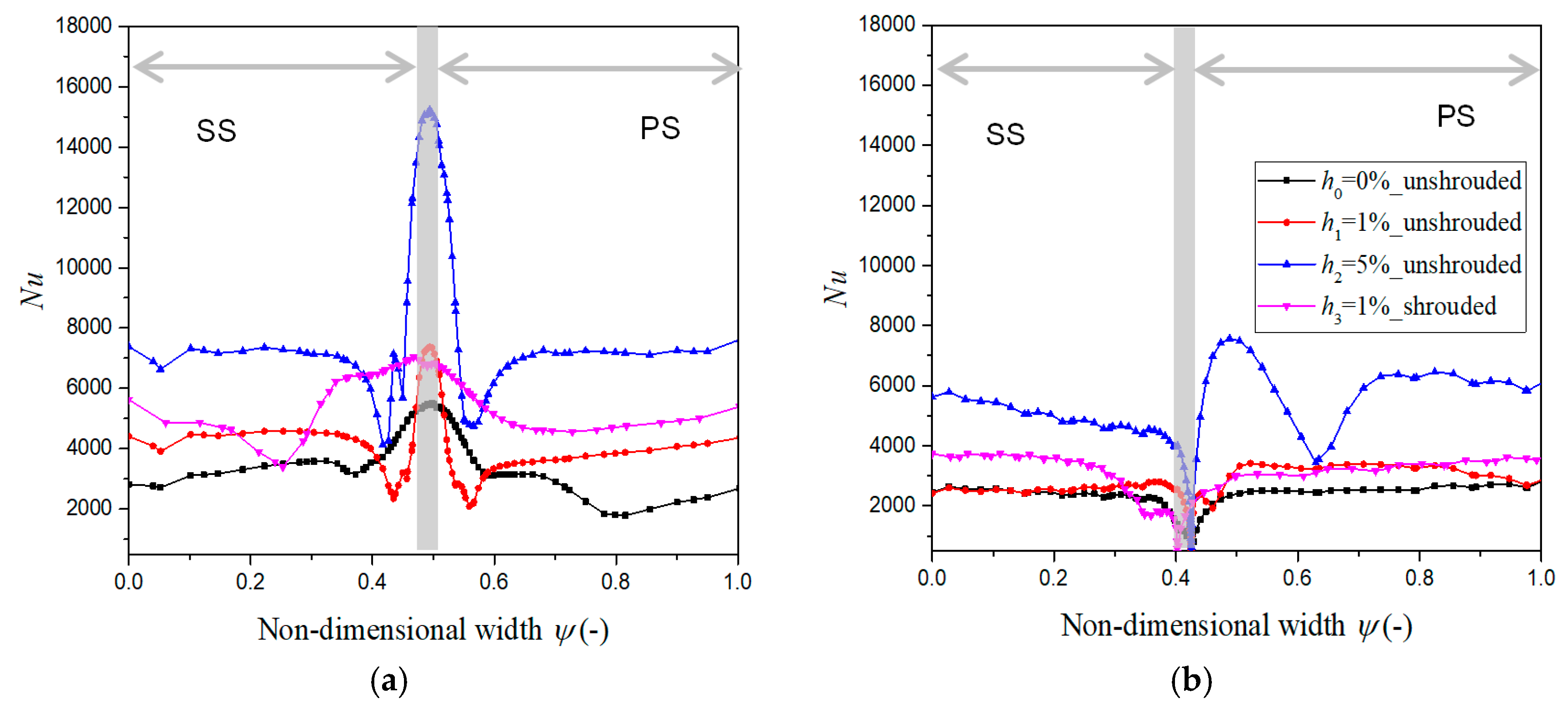
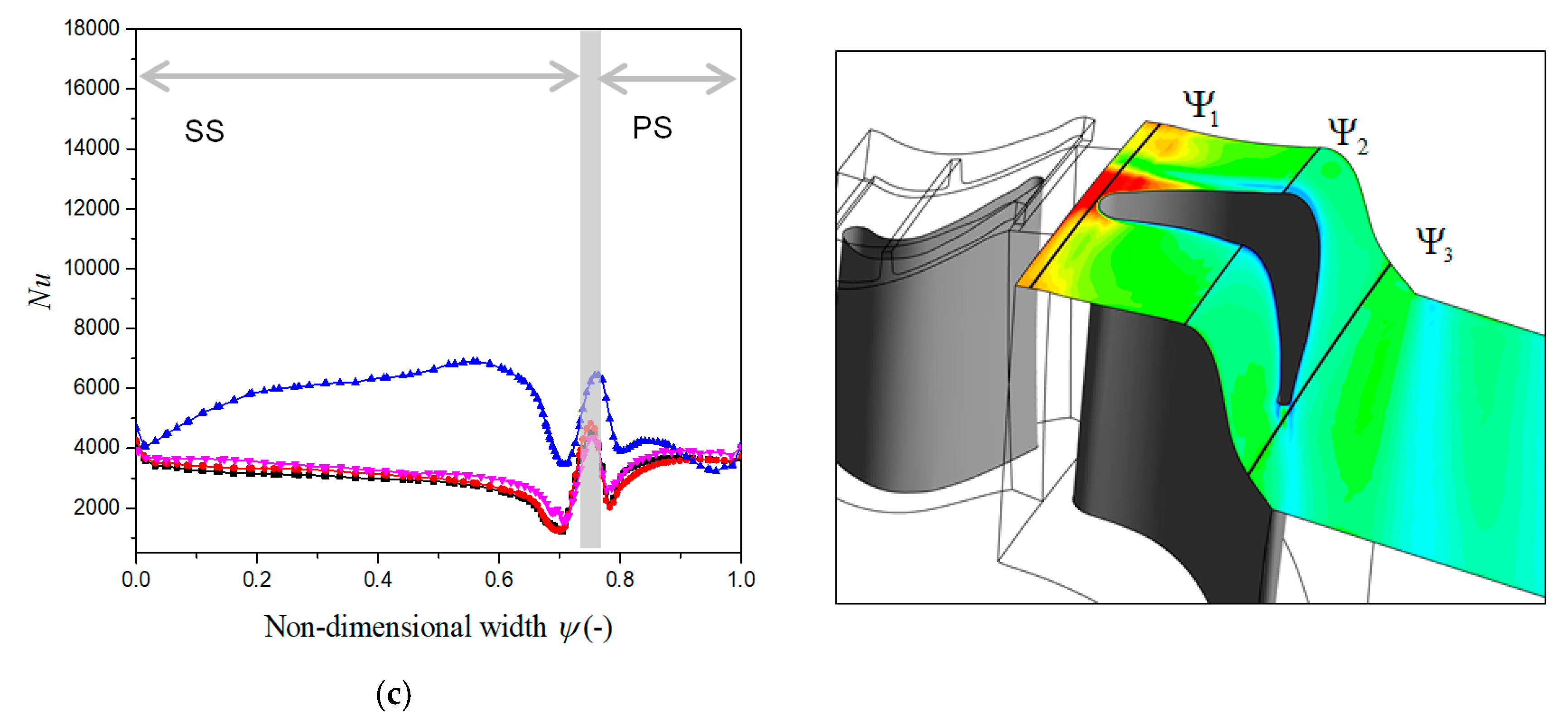
| Parameters Name | Value |
|---|---|
| Inlet total pressure (kPa) | 1947.4 |
| Inlet total temperature (K) | 1543.9 |
| Exit static pressure (kPa) | 396.7 |
| Inlet flow angle (°) | 0 |
| Design mass flow rate (kg/s) | 76.5 |
| Inlet hub/tip radius ratio (S1,R1,S2) | 0.864, 0.886, 0.863 |
| Exit hub/tip radius ratio (S1,R1,S2) | 0.886, 0.868, 0.797 |
| Pitch at midspan (mm) (S1,R1,S2) | 71, 36, 61 |
| Number of vanes (S1,R1,S2) | 40, 86, 45 |
| Tg/Tw | 1.5 |
| Number of Mesh Nodes (million) | Loss Coefficient Cp | Area-Averaged Casing Heat Flux (w/m2) | Simulation Time (103 s) | |
|---|---|---|---|---|
| Mesh-1 | 3.09 | 0.130955 | 378156 | 18.9 |
| Mesh-2 | 7.26 | 0.126102 | 385201 | 24.7 |
| Mesh-3 | 11.32 | 0.126082 | 383153 | 27.7 |
| Schemes | Parameter Setting | Value | Code |
|---|---|---|---|
| Case 0 | h0 = 0% blade height | 0 mm | h0 = 0%_unshrouded |
| Case 1 | h1 = 1% blade height | 0.6 mm | h1 = 1%_unshrouded |
| Case 2 | h2 = 5% blade height | 2.9 mm | h2 = 5%_unshrouded |
| Case 3 | h3 = 1% blade height h4 = 2% blade height | 0.6 mm 1.2 mm | h3 = 1%_shrouded |
| Case | Loss Coefficient Cp | Area-Averaged Blade Heat Flux (w/m2) | Area-Averaged Casing Heat Flux (w/m2) |
|---|---|---|---|
| h0 = 0%_unshrouded | 0.126082 | 441894 | 383153 |
| h1 = 1%_unshrouded | 0.135743 | 478626 | 454382 |
| h2 = 5%_unshrouded | 0.167639 | 624361 | 687022 |
| h3 = 1%_shrouded | 0.137689 | 454125 | 466300 |
© 2019 by the authors. Licensee MDPI, Basel, Switzerland. This article is an open access article distributed under the terms and conditions of the Creative Commons Attribution (CC BY) license (http://creativecommons.org/licenses/by/4.0/).
Share and Cite
Meng, F.; Zheng, Q.; Gao, J.; Fu, W. Effect of Tip Clearance on Flow Field and Heat Transfer Characteristics in a Large Meridional Expansion Turbine. Energies 2019, 12, 162. https://doi.org/10.3390/en12010162
Meng F, Zheng Q, Gao J, Fu W. Effect of Tip Clearance on Flow Field and Heat Transfer Characteristics in a Large Meridional Expansion Turbine. Energies. 2019; 12(1):162. https://doi.org/10.3390/en12010162
Chicago/Turabian StyleMeng, Fusheng, Qun Zheng, Jie Gao, and Weiliang Fu. 2019. "Effect of Tip Clearance on Flow Field and Heat Transfer Characteristics in a Large Meridional Expansion Turbine" Energies 12, no. 1: 162. https://doi.org/10.3390/en12010162
APA StyleMeng, F., Zheng, Q., Gao, J., & Fu, W. (2019). Effect of Tip Clearance on Flow Field and Heat Transfer Characteristics in a Large Meridional Expansion Turbine. Energies, 12(1), 162. https://doi.org/10.3390/en12010162





